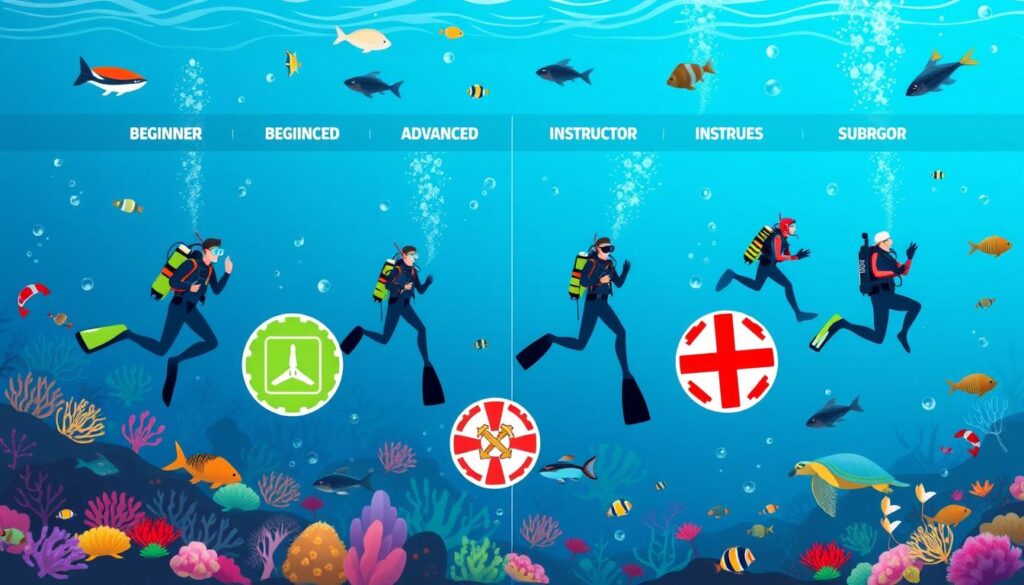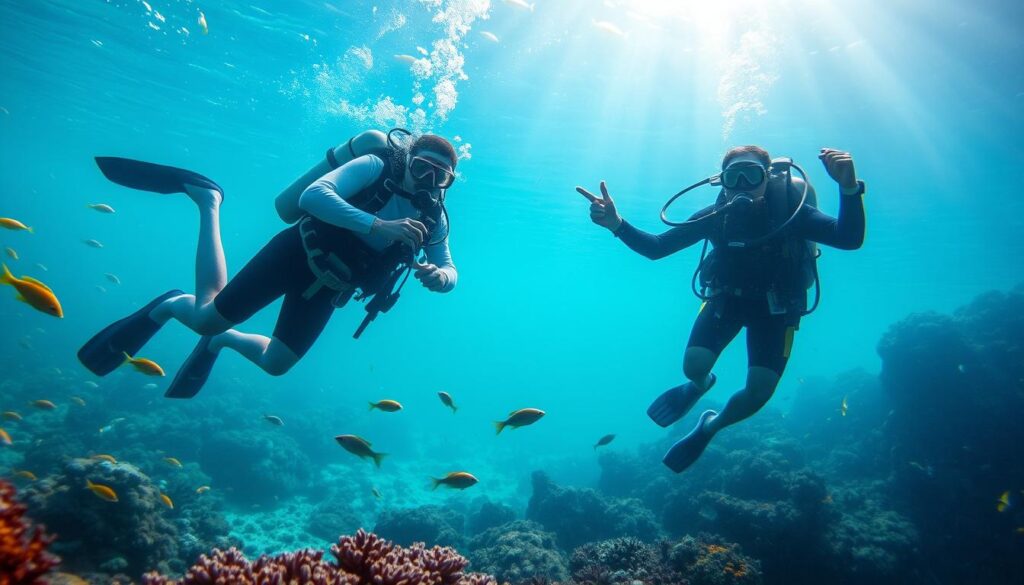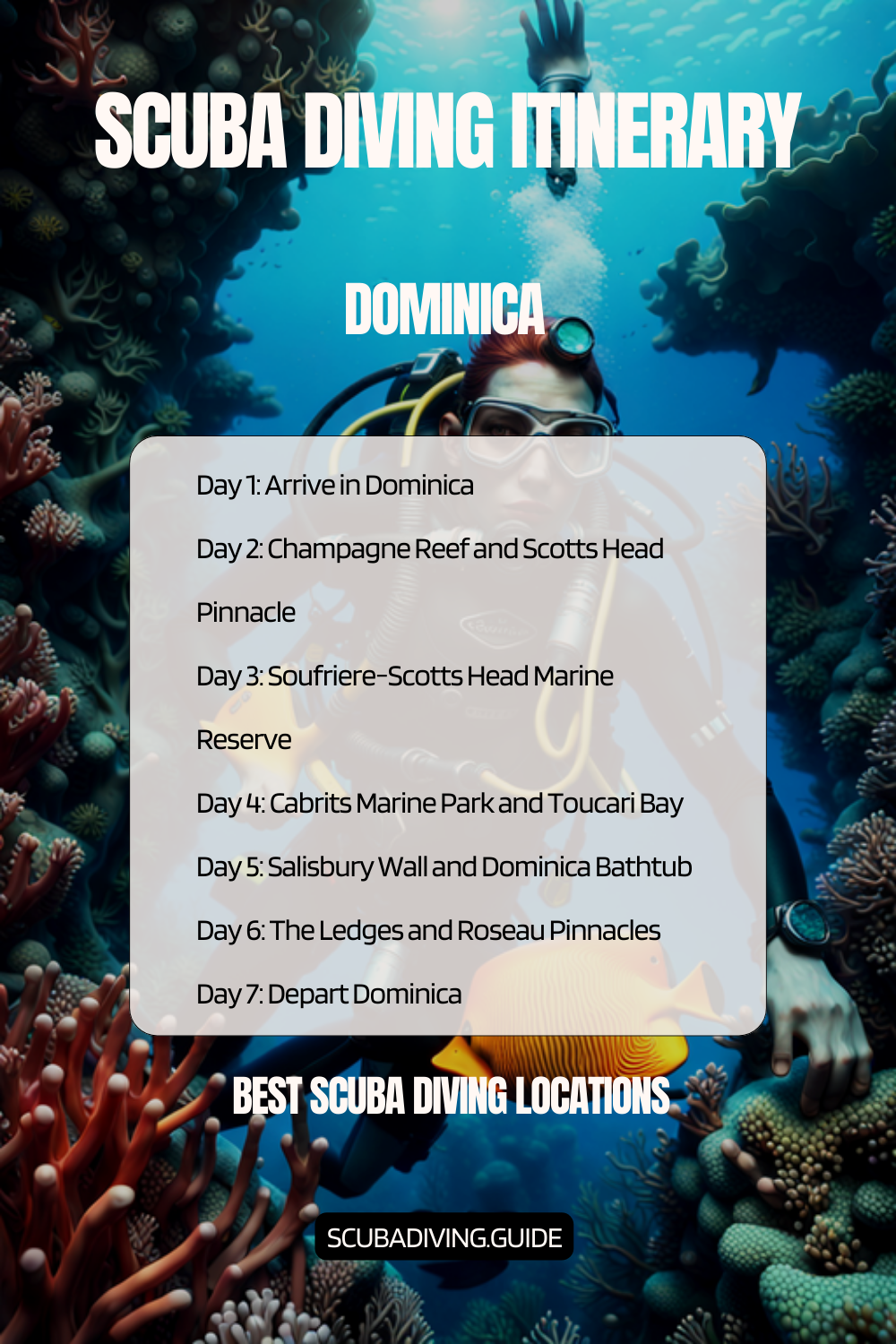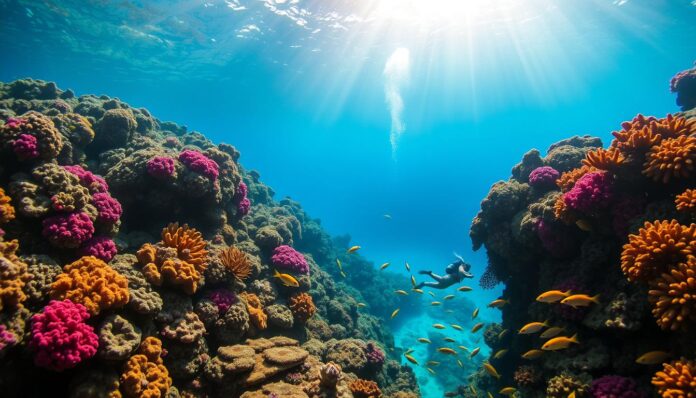| Best Time to Travel | February to May |
| What to Expect | Warm water, clear visibility, diverse marine life |
| Diving Conditions | Year-round, but best from February to May |
| Marine Life | Whale sharks, sea turtles, stingrays, sharks, dolphins, fish |
Are you ready to explore an underwater paradise? Dominica, known as the “Nature Island of the Caribbean,” offers an amazing scuba diving experience. It will change how you see underwater forever.
Scuba diving in Dominica is more than a tropical adventure. It’s a journey to one of the most untouched marine environments. The waters are crystal clear, with visibility of 20-30 meters. The temperature is always warm, at 27°C.
Dominica’s underwater world is unlike anywhere else. You’ll find volcanic pinnacles and vibrant coral reefs. The island’s marine reserves have stunning dive sites. Here, you can see up to 22 different whale species.
Key Takeaways – Scuba Diving in Dominica
- Dominica offers world-class scuba diving experiences with exceptional water clarity
- Warm year-round temperatures make diving accessible throughout the seasons
- Unique underwater landscapes including volcanic formations and coral reefs
- Home to diverse marine ecosystems with multiple whale species
- Affordable diving options starting at less than $50 per dive

Introduction to Scuba Diving in Dominica
Dominica is a perfect spot for underwater adventures in the Caribbean. It’s known as the “Nature Island.” Here, divers find a unique underwater world filled with amazing marine life and colorful ecosystems.
Why Choose Dominica for Scuba Diving?
There are many reasons to dive in Dominica. The island has:
- Water temperatures ranging from 70-85°F
- Visibility between 60-100 feet
- Year-round diving opportunities
- Minimal tourist crowds
“Dominica offers a diving experience that feels like a personal encounter with nature’s most beautiful underwater secrets.”
Overview of Dominica Marine Life
The marine life in Dominica is incredible. Divers can see many different species. Some of the creatures you might see include:
| Marine Species | Diving Locations |
|---|---|
| Electric Rays | Champagne Reef |
| Seahorses | Soufriere Pinnacles |
| Caribbean Reef Squid | Point Break |
| Sea Snakes | Rina’s Hole |
The island’s unique features, like underwater volcanoes, make diving special. From November to March, you might see sperm whales. This adds to the excitement of exploring the underwater world.
Dominica has dive sites with canyons, walls, and craters. It offers a diving experience unlike any other in the Caribbean.
Best Scuba Diving Locations in Dominica
Dominica is a top spot for scuba diving in the Caribbean. It has amazing underwater scenes for all divers. The island has three marine reserves: Cabrits National Park Marine Section, Salisbury Marine Reserve, and Soufriere Scotts Head Marine Reserve.
Divers can see many underwater worlds. From steep drop-offs to colorful coral, each dive is unique. These sites offer unforgettable underwater adventures.
Champagne Reef: A Hot Spring Wonder
Champagne Reef is a special dive spot. Thousands of bubbles come out of underwater fissures. It’s like swimming in a natural champagne glass. Key features include:
- Suitable for all diving levels
- Calm waters with light currents
- Underwater hot springs releasing distinctive bubbles
Dive Spots in the Soufrière-Scott’s Head Marine Reserve
This reserve is the most visited diving spot in Dominica. It has many sites with different marine life.
| Dive Site | Depth Range | Notable Features |
|---|---|---|
| Scott’s Head Pinnacle | 35 ft – 120 ft | Exceptional visibility, diverse marine life |
| Crater’s Edge | Varies | Large fish species like black jack and bar jacks |
| Point Break | 30 ft – 120 ft | Extensive marine biodiversity |
The Anse d’Arlet: A Hidden Gem
This spot is less known but offers a quiet dive experience. It has rich marine life and diverse sea creatures.
“Dominica’s underwater world is a testament to the incredible marine biodiversity of the Caribbean.” – Marine Exploration Society
Every dive site in Dominica has permanent moorings for safe diving. A small marine park user fee helps keep these treasures safe. Visitors should be ready to pay this fee to support marine conservation.
What to Expect Underwater
Dominica Marine Life offers an extraordinary underwater experience. It attracts divers from all over the world. The island’s unique marine ecosystem presents a vibrant underwater landscape.
Diverse Marine Species Encounters
Divers can discover a rich array of marine creatures in Dominica’s waters. The underwater ecosystem supports an impressive variety of smaller marine life, including:
- Colorful crabs
- Fascinating shrimp
- Delicate starfish
- Mysterious eels
- Unique yellow-headed jawfish
- Camouflaged frogfish
- Intriguing leaf fish
Coral Reefs and Underwater Ecosystems
The underwater world of Dominica boasts remarkable ecosystems. Soft corals here are estimated to be up to 150 years old. While large marine species like sharks are absent, the reef systems provide a rich and diverse environment for underwater exploration.
| Marine Ecosystem Feature | Characteristic |
|---|---|
| Coral Age | Up to 150 years old |
| Water Temperature | Consistent 83 degrees Fahrenheit |
| Underwater Landscape | Volcanic sand, boulders, diverse terrain |
Wreck Diving Opportunities
While extensive wreck diving might be limited, Dominica offers unique underwater experiences. The volcanic terrain provides dramatic underwater landscapes that compensate for the lack of traditional wreck sites.
“Dominica’s underwater world is less about quantity and more about the intricacy of marine ecosystems.” – Local Dive Instructor
Underwater exploration in Dominica promises an intimate and immersive experience with marine life. It is characterized by its pristine and unspoiled environments.
Scuba Diving Certifications and Requirements
Diving in Dominica needs you to know the Diving Certification Requirements and Safety Protocols. It doesn’t matter if you’re new or have lots of diving experience. Knowing the right certification levels is key for a safe and fun dive.

Dominica’s dive spots are open to all skill levels. They have specific certification needs to keep everyone safe and happy.
Certification Levels for Diving in Dominica
- Open Water Diver: This is the starting point, costing $562.00, and includes full training.
- Advanced Open Water Diver: You must be at least 12 years old and have a previous certification.
- Specialty Courses available:
- Deep Diving: $225 for 3 dives
- Night Diving: $245 for 3 dives
- Underwater Photography: $175 for 2 dives
Age and Health Restrictions
Scuba diving safety is a big deal. Here are some important rules:
- Minimum age for Discover Scuba Diving: 10 years old
- Maximum depth for beginners: 40 feet
- Medical clearance is advised for those with certain health issues
“Proper certification is your passport to exploring Dominica’s underwater wonders safely”
Dive centers like Fort Young Dive, a PADI Dive Center, provide detailed training. Prices vary from $91 for a 1-tank shore dive to $206 for a 2-tank boat dive. All courses include a 15% tax and a $2 marine park fee.
Don’t forget to plan for extra costs. Equipment rental is $25 per day, and there might be a marine park user fee of $2 per dive.
Choosing a Scuba Diving Operator
Finding the right dive operator is key to a great underwater adventure in Dominica. The island has many dive shops. It’s important to think about a few key things when choosing.
Looking for the best Dive Tour Packages in Dominica needs a smart plan. The island has many trusted dive centers. They focus on safety and giving great experiences.
Top Dive Shops in Dominica
- Nature Island Dive (Soufriere)
- SALT Dominica (Toucari)
- Fort Young Hotel Dive Center (Roseau)
Key Factors for Selecting a Dive Operator
When looking at dive operators, keep these important points in mind:
- Safety Protocols: Check if they follow strict safety rules
- Quality and upkeep of their equipment
- How well their instructors are trained
- If they care about the marine environment
“The right dive operator turns a good trip into an unforgettable one.”
Diving Operator Comparison
| Operator | Specialties | Experience | Group Size |
|---|---|---|---|
| Nature Island Dive | Advanced reef exploration | 10+ years | Small groups (4-6 divers) |
| SALT Dominica | Marine conservation tours | 5+ years | Personalized experiences |
| Fort Young Hotel Dive Center | Beginner-friendly Dive Tour Packages | 8+ years | Flexible group sizes |
By looking at these factors, divers can pick a safe, educational, and fun underwater trip in Dominica’s beautiful marine spots.
Gear and Equipment for Scuba Diving
Getting ready for an underwater adventure in Dominica means picking the right scuba gear. The right equipment is key for a safe and fun dive. Knowing your options for Scuba Gear Rentals and following Safety Protocols is important.
Essential Scuba Diving Gear Checklist
Exploring Dominica’s underwater world needs the right gear. Here’s what you need:
- Mask and snorkel
- Fins
- Wetsuit or exposure protection
- Buoyancy Compensator Device (BCD)
- Regulator set
- Dive computer
- Dive light
Rental vs. Personal Equipment: Making the Right Choice
Divers in Dominica have two main choices for gear. Let’s look at the good and bad sides:
| Rental Option | Bringing Personal Gear |
|---|---|
| Convenient for travelers | Familiar equipment |
| Lower upfront cost | Customized fit and comfort |
| No maintenance required | Consistent performance |
Scuba Gear Rentals in Dominica have flexible prices. You can rent for a day or a week:
- Complete scuba set daily rental: $45.00
- Complete scuba set weekly rental: $225.00
- Individual item rentals range from $3.00 to $20.00 daily
“Proper gear preparation is the key to a safe and memorable diving experience.”
When choosing your gear, focus on Safety Protocols. Make sure all equipment is in good shape and fits right. Local dive shops in Dominica offer expert advice and top-notch rental options for the island’s unique diving conditions.
The Best Times to Dive in Dominica
Scuba diving fans looking for top Caribbean spots will love Dominica. It’s a diving paradise all year round. The island’s marine life is amazing, drawing divers from everywhere.
Diving in Dominica is great all year, but some seasons are better than others. Knowing when to dive can make your trip even better.
Seasonal Weather Patterns
Dominica’s diving is shaped by two main seasons:
- Dry Season: November to April
- Best diving visibility (up to 100 ft)
- Water is warm, between 26°C to 28°C
- Weather is most stable
- Wet Season: May to October
- More rain means more dives cancelled
- Visibility might be less
- Water is a bit warmer
Optimal Months for Scuba Diving
For the best diving, check out these months:
- November to March: Great for seeing sperm whales
- December to April: Best diving weather
- June to September: Perfect for spotting small marine life
“Dominica offers an underwater adventure for every season, making it a true Caribbean diving gem.”
Looking for whales, coral, or unique sea life? Dominica has it all. Dive here any time of year for an unforgettable experience.
Safety Tips for Scuba Divers
Diving in Dominica’s marine environment needs careful safety attention. The island’s underwater landscape, with steep sides and deep waters, requires skilled navigation and preparation.

Exploring Dominica’s underwater world safely involves several key steps. Getting proper training and knowing diving certification rules are essential for a safe dive.
Essential Safety Gear Every Diver Needs
- Surface Marker Buoy (SMB) for visibility
- Dive computer to track depth and time
- Backup air source or alternate breathing device
- First aid kit for marine emergencies
- Waterproof communication device
Emergency Preparedness Strategies
Divers need a detailed emergency plan. Quick thinking and proper training are key in underwater emergencies.
- Always dive with a buddy
- Check equipment before diving
- Know your personal limits
- Learn basic underwater rescue techniques
- Understand local marine conditions
“Safety doesn’t happen by accident. It requires preparation, knowledge, and constant vigilance.” – Professional Diving Instructor
Dominica’s marine environment is a top dive spot in the Caribbean. It offers amazing experiences with respect and careful planning. By following strict safety protocols and keeping up with diving certification, divers can explore this world confidently and safely.
Marine Conservation Efforts in Dominica
Dominica is leading the way in protecting its underwater world. This island is a shining example of Eco-Tourism. It’s all about keeping the marine life thriving.
The Soufriere Scotts Head Marine Reserve (SSMR) is at the heart of these efforts. It’s a Marine Protected Area (MPA) that guards vital underwater spots. These areas are home to a wide range of marine life.
Initiatives to Protect Marine Life
Dominica has started several important projects:
- Working with REEF Environmental Education Foundation
- Controlling lionfish to keep the ecosystem in balance
- Getting help from local people and non-profits
“Our marine ecosystems are not just habitats, they are living treasures that require our dedicated protection.” – Local Marine Conservationist
How Divers Can Get Involved
Divers have a big role to play in saving the sea. The Green Fins Code of Conduct helps them dive responsibly:
- Keep your buoyancy skills sharp
- Never touch the sea creatures
- Don’t use gloves
- Don’t feed the marine animals
| Conservation Focus Area | Key Actions |
|---|---|
| Coral Protection | Combating Stony Coral Tissue Loss Disease |
| Ecosystem Balance | Controlling Invasive Lionfish Populations |
| Community Involvement | Supporting Local Conservation Efforts |
Divers can help by supporting groups like Oceans Forward. This non-profit works hard to protect the sea. Every dive is a chance to learn, respect, and protect Dominica’s ocean.
Local Culture and Scuba Diving
Dominica is a special place where diving meets culture. The island’s rich culture and marine life blend together. This creates a unique experience that connects visitors with local traditions and community life.
Diving in Dominica is not just an adventure. It’s a journey into the local culture. Local communities work hard to protect the marine ecosystems. They share their deep connection to the ocean with visitors.
Interactions with Local Communities
Dominica is known for its real community connections. Visitors can have deep conversations with local dive guides. These guides share their family’s knowledge of the sea.
- Learn traditional fishing techniques from local experts
- Participate in community-led marine conservation programs
- Engage with Carib Indian descendants who have deep oceanic traditions
Unique Cultural Experiences
“Our ocean is our life, our history, our future.” – Local Dominican Fisherman
Eco-tourism in Dominica is different from usual tourist activities. Visitors can dive into cultural practices. These highlight the island’s deep bond with the sea.
- Attend traditional storytelling sessions about sea legends
- Join local marine festivals celebrating ocean heritage
- Support community-run diving and marine tourism initiatives
By choosing local guides and supporting community-based tourism, divers help protect Dominica’s unique marine and cultural heritage.
Additional Activities for Divers
Dominica is more than just a place for underwater adventures. It offers a wide range of activities for those who love the sea. While diving is the main draw, there’s plenty to do on land too.
Unforgettable Snorkeling Spots
Looking for something less intense? Dominica has amazing snorkeling spots. You can see colorful fish and coral without needing scuba gear.
- Champagne Reef: Unique underwater hot springs create bubbling environment
- Soufrière-Scott’s Head Marine Reserve: Rich marine biodiversity
- Scotts Head Peninsula: Crystal-clear waters perfect for snorkeling
Land-Based Adventures
But there’s more to see than just the sea. Dominica’s green landscapes offer exciting land-based activities. These adventures are perfect for balancing your diving trips.
| Adventure Type | Duration | Estimated Cost |
|---|---|---|
| Hiking to Waterfalls | 2-4 hours | $35-$65 |
| Kayaking Layou River | 3 hours | $45-$75 |
| Carib Territory Exploration | Half-day | $50-$90 |
“Dominica offers a perfect blend of underwater wonders and terrestrial adventures for the curious traveler.” – Local Tourism Board
Whale watching tours are another highlight, costing about $69 per person. You can see 22 out of 33 Caribbean cetacean species here.
Combining diving with these activities makes for a unique Caribbean experience. It’s more than just exploring the sea.
Dominica Recommended Diving Itinerary
When planning a diving trip to Dominica, it’s important to consider the variety of dive sites and the unique underwater experiences each one offers. To make the most of your diving adventure, here’s a recommended itinerary that highlights some of the must-visit locations in Dominica:
Day 1: Arrive in Dominica
Upon arrival in Dominica, settle into your accommodation and take some time to familiarize yourself with the surroundings. If you arrive early enough, consider a shore dive at a nearby dive site to start your underwater exploration.
Day 2: Champagne Reef and Scotts Head Pinnacle
Begin your diving journey with a visit to Champagne Reef, a unique site known for its volcanic activity. Dive among the warm bubbles that create a champagne-like effect and explore the vibrant coral formations. In the afternoon, head to Scotts Head Pinnacle, where you can marvel at the marine life that congregates around this underwater pinnacle.
Day 3: Soufriere-Scotts Head Marine Reserve
Spend a day exploring the diverse dive sites within the Soufriere-Scotts Head Marine Reserve. Start with Danglebens Pinnacles, a site famous for its towering coral formations and abundance of marine life. Continue to Coral Gardens, where you can encounter seahorses, lobsters, and other fascinating creatures that call this reef home.
Day 4: Cabrits Marine Park and Toucari Bay
Venture to Cabrits Marine Park, where you can dive among coral reefs, volcanic formations, and seagrass beds. Explore the park’s diverse sites and enjoy encounters with tropical fish, rays, and turtles. In the afternoon, head to Toucari Bay, a picturesque dive site ideal for underwater photography and discovering the colorful reef ecosystem.
Day 5: Salisbury Wall and Dominica Bathtub
Embark on a thrilling wall dive at Salisbury Wall, where you can descend into the depths and witness the impressive coral formations and marine life. Afterward, make your way to Dominica Bathtub, a natural rock formation that creates a tranquil swimming area. Take a break from diving and enjoy the crystal-clear waters.
Day 6: The Ledges and Roseau Pinnacles
Explore The Ledges, an exciting dive site characterized by its unique topography and hidden crevices. Dive along the sloping ledge and encounter lobsters, moray eels, and other fascinating marine creatures. In the afternoon, venture to Roseau Pinnacles, where you can dive among underwater volcanic peaks and marvel at the vibrant coral formations.
Day 7: Depart Dominica
On your last day, take a moment to reflect on your incredible diving adventures in Dominica. If time allows, consider a final dive or snorkel session before bidding farewell to this captivating island.
Please note that this itinerary is just a suggestion, and the actual diving plan may vary based on your preferences, dive conditions, and the duration of your stay. It’s always important to consult with local dive operators or dive centers for the most up-to-date information and to tailor the itinerary to your specific interests and skill level.

Other Countries to Consider
- Anguilla
- Antigua and Barbuda
- Aruba
- Bahamas
- Barbados
- Bonaire
- British Virgin Islands
- Cayman Islands
- Cuba
- Curaçao
- Dominican Republic
- Grenada
- Guadeloupe Islands
- Haiti
- Jamaica
- Martinique
- Montserrat
- Puerto Rico
- Saba
- Saint Barthélemy
- Saint Kitts & Nevis
- Saint Lucia
- Saint Vincent and the Grenadines
- Sint Eustatius
- Sint Maarten
- The Turks And Caicos Islands
- Trinidad and Tobago
- United States Virgin Islands
Conclusion: Making the Most of Your Dive Trip
Scuba diving in Dominica is an amazing underwater journey. It mixes top-notch marine exploration with Caribbean charm. The island has dive sites for all, from newbies to experts, making it perfect for dive packages.
When planning your dive trip to Dominica, pick the best time. The dry season, from December to April, has great diving conditions. Nature Island Dive offers two-tank dive packages for $100 USD, including snorkeling and kayaking.
Planning Your Dive Holiday
Choosing the right place to stay can make your dive trip better. Dominica has many options, from beach cottages to hotels with dive centers. The island’s recovery from Hurricane Maria means you’ll find comfortable places to stay.
Recommended Itineraries
Your dive trip should mix underwater adventures with cultural experiences. Think about diving and visiting Trafalgar Falls, exploring Kalinago territory, or enjoying Carnival in Roseau. Dominica’s dive sites are full of life and beauty, promising an unforgettable diving adventure.
FAQ – Scuba Diving in Dominica
Do I need a specific certification to dive in Dominica?
Yes, most dive sites in Dominica need at least an Open Water certification. Beginners can start with introductory courses from local dive operators. Advanced sites like the Soufrière Pinnacles might require Advanced Open Water certification. Always check with your dive operator about site requirements and your skill level.
What is the best time of year to go scuba diving in Dominica?
The best diving time in Dominica is from December to April. During this period, visibility is up to 100 feet, and water temperatures are between 79-84°F. The dry season offers the most stable diving conditions. Experienced divers can dive year-round, though.
How much does scuba diving cost in Dominica?
Dive prices range from $75 to $150 per dive, based on location and operator. Full-day dive packages cost between $120-$250. These packages include equipment rental, guided tours, and transportation. Many resorts and dive shops offer discounts for longer stays.
What marine life can I expect to see while diving?
Dominica is home to incredible marine biodiversity. Divers can see sperm whales, sea turtles, sharks, colorful fish, seahorses, and coral formations. The Champagne Reef is famous for its underwater hot springs and diverse marine life.
Are there any specific safety concerns for diving in Dominica?
Dominica is generally safe for diving, but always follow safety protocols. Be cautious of strong currents, mainly around volcanic formations. Make sure you have dive insurance, stay within your limits, and dive with a reputable operator.
Can I rent diving equipment on the island?
Yes, most dive shops in Dominica offer equipment rentals. Prices are $15-$40 per piece. For the best fit, many experienced divers bring their own essential gear like masks, fins, and wetsuits.
Is Dominica good for beginner divers?
Dominica is great for divers of all levels. Sites like Champagne Reef are perfect for beginners, with calm waters and fascinating marine life. Many dive operators provide courses and guided dives for less experienced divers.
How can I contribute to marine conservation while diving?
Choose eco-friendly dive operators and follow marine park rules. Avoid touching marine life and use reef-safe sunscreen. Consider joining local conservation programs. Many dive centers in Dominica support marine protection and welcome environmentally conscious divers.
What should I pack for a diving trip to Dominica?
Pack your diving certification card, dive computer, personal gear, reef-safe sunscreen, underwater camera, quick-dry towels, and lightweight clothing. Don’t forget sunglasses, a hat, and waterproof protection for electronics.
Are there any unique diving experiences in Dominica?
Yes! Dominica offers unique dives like exploring underwater volcanic vents at Champagne Reef and diving near the 18th-century shipwreck at Cottage Point. You might even see sperm whales. The island’s untouched marine environment offers extraordinary underwater adventures.
